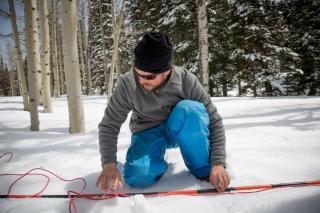March 1 Water Supply Outlook Report for Utah

The storms we received in February gave Utah’s snowpack a nice boost: from 6.2” statewide snow water equivalent (SWE) at the beginning of the month to 10.2” by March 1st. While it's statistically very unlikely that Utah will reach 'normal' peak snowpack conditions by early April, this extra SWE has improved our outlook for runoff when it all melts. Unfortunately, the outlook is still pretty dire…
As of March 1st, the snow water equivalent (SWE) measured at our SNOTEL sites is 77% of normal statewide, compared with 65% last month. The Southwestern Utah, Southeastern Utah, and Price-San Rafael basin are faring the worst at 55%, 62%, and 63% of normal SWE, respectively. With only one month remaining until our typical snowpack peak, our statewide SWE needs to improve by 5.3” to achieve ‘normal’ conditions, which now only has a <10% likelihood of occurring. February precipitation was above average at 111%, but the water-year-to-date precipitation for the state remains well below average at only 70%. Soil moisture levels in the state remain exceptionally dry—currently at only 29% of saturation (or roughly 57% of normal). As noted in last month’s report, Utah’s poor snowpack conditions, extremely dry soils, and low antecedent streamflow are impacting runoff conditions; streamflow forecasts for April to July snowmelt runoff volume are generally between 25% and 75% of average. The largest improvements are in areas hit hardest by February’s storms, such as the forecast for Big Cottonwood Creek which increased by nearly 20%. On the other hand, several forecast points remain extremely low, such as South Creek near Monticello (22% of normal) and others.
Utah’s reservoir storage is currently at 67% of capacity, down 14% from last year. When combined with the low forecasts, the resulting Surface Water Supply Indices for Utah basins are alarmingly low. It is now very likely that Utah will experience below to well-below average water supply conditions for the 2021 water year. Water managers should plan accordingly.
Please click here for the full report.

